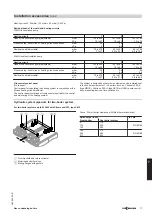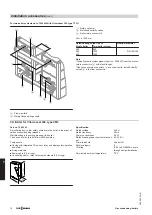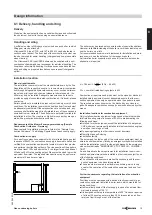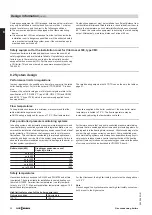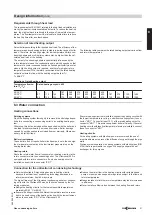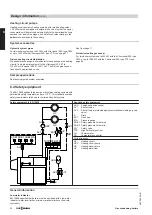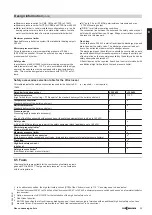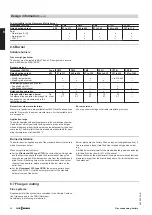
Combustion equipment for LPG (propane, butane and their mixtures)
may only be installed in rooms whose floor is more than 1 m below
ground level at every point, subject to the following conditions:
■ The combustion equipment is equipped with a flame monitoring
device.
■ It is ensured that LPG cannot escape from the fuel lines inside the
installation room in dangerous quantities or will be extracted safely
via a mechanical ventilation system, even if the combustion equip-
ment has been switched off.
Combustion equipment must be installed at a sufficient distance from
combustible materials and fitted furniture, or be shielded from them, to
ensure the temperature on such materials/furniture does not exceed
85 °C when the combustion equipment is delivering the rated heating
output. Alternatively, maintain a distance of at least 40 cm.
Safety equipment for the installation room for Vitocrossal 300, type CM3
Viessmann boilers are tested and approved in accordance with all
safety regulations and are therefore fail-safe. Unpredictable, external
factors may, in the rarest of cases, lead to the potentially harmful
escape of carbon monoxide (CO). For this case, we recommend using
a CO limiter. This can be ordered as a separate accessory (part no.
7499 330).
8.2 System design
Performance limits in regulations
In many regulations, the conditions to be met are subject to the rated
boiler heating output. For this, the output at TF/TR 80/60 °C is deci-
sive.
However, the output levels given in this technical guide relate to the
specification at TF/TR 50/30 °C (type CM2, CM3, CT3U and CR3B)
and 40/30 °C (type CT3B), which is now commonly applied to con-
densing boilers.
The rated heating outputs at both TF/TR can be found in the table on
page 21.
Flow temperatures
To keep distribution losses to a minimum, we recommend that the:
■ Heat distribution system and the
■ DHW heating is designed for a max. of 70 °C (flow temperature).
On boilers supplied with a boiler control unit, the max. boiler water
temperature is limited to 75 °C. The flow temperature may be
increased by adjusting the temperature controller.
Pump controlled pressure maintaining systems
In heating systems with automatic pressure maintaining systems, and
in particular pump controlled systems with integral deaeration, we rec-
ommend the installation of a diaphragm expansion vessel for individual
boiler protection. This reduces the frequency and level of pressure
fluctuations. This contributes considerably to improved operational
reliability and longer service life of the system components. Failure to
observe these recommendations may result in damage to the boiler or
to other system components.
Boiler output (kW)
Diaphragm expansion vessel
Capacity in litres
up to 300
50
up to 500
80
up to 1000
140
up to 2000
300
up to 5000
800
up to 10,000
1600
Furthermore ensure that only pump controlled pressure maintaining
systems that are sealed against corrosion and protected against oxy-
gen ingress into the heating water are used. Otherwise damage to the
system through oxygen corrosion can result. Pump controlled pres-
sure maintaining systems with atmospheric deaeration through cycli-
cal pressure release create a central post-ventilation of the heating
system. However, this does not represent oxygen removal in the sense
of corrosion protection as described in VDI 2035 Sheet 2.
Safety temperatures
Viessmann boilers correspond to EN 303 and DIN 4702 and all are
type-tested. They are suitable for installation in sealed heating sys-
tems to EN 12828. Permiss. flow temperatures (= safety tempera-
tures): up to 110 °C. Max. achievable flow temperature: approx. 15 K
below the safety temperature.
High limit safety cut-out of the boiler control unit
Delivered condition
Adjustable to
110 °C
100 °C
For the Vitocrossal, the high limit safety cut-out must be changed over
to 100 °C.
Note
Once changed, the hydraulic-mechanical high limit safety cut-out can-
not be reset to the higher value.
Design information
(cont.)
20
VIESMANN
Gas condensing boilers
8
5822 449 GB












